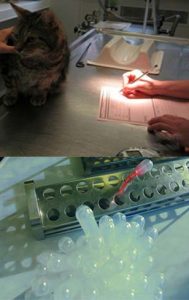Ron Hines DVM PhD
One low thyroid test doesn’t mean that your pet is hypothyroid? Read about that here
T3 = Triiodothyronine – The Level In Your Dog Or Cat’s Blood
Hypothyroidism
Hyperthyroidism
Your veterinarian might run a T3 test on your cat or on your dog when he/she is interested in knowing how well its thyroid gland is functioning. Your pet’s thyroid gland produces two forms of thyroid hormone, T3 and T4. Your dog and cat’s thyroid gland produces most these two hormones as T4. That T4 hormone is later converted into T3 at other locations in your pet’s body. Of the two, T3 has by far the more powerful effect on metabolism. Your cat or your dog’s metabolic rate, its heart rate, its respiratory rate and its body temperature are all very dependent on the amount of T3 that is eventually made available. All supplemental oral thyroid hormone given to thyroid-deficient pets, is T4 (levothyroxine).
A complete thyroid panel analysis consists of five or six different assays to judge the health of your pet’s thyroid gland. Those test check the amount of T3, T4, free T4 (by equilibrium dialysis), TSH and thyroglobin autoantibody that is present in its blood. Knowing all four values helps your veterinarian decide the underlying cause of your pet’s thyroid problems. It also helps your vet monitor the effectiveness of the treatment he or she provides. These tests can also be used by certifying organizations (such as the OFA) to pre-screen potential breeder animals for any genetic tendency toward thyroid gland problems.
Your pet’s T3 levels can also be reported as low in many non-thyroid health issues. When T3 is found to be low in your pet, some of those other five tests might need to be run to be certain your dog or your cat is truly hypothyroid. Placing non-hypothyroid dogs on thyroid medication is not an uncommon error. Just about any whole-body (systemic) disease can cause low thyroid hormone levels.
T3 (along with TSH level) can be helpful in deciding if sight hounds (e.g. greyhounds, etc.) are truly hypothyroid. These swift breeds often have T-4 levels that would be considered low in other breeds. But in sight hounds they are actually normal. In sight hounds low T3 levels are a better indication of true hypothyroidism than low T4 levels.
Reasons Why Your Cat Or Dog’s T3 Level Could Be High:
T3 levels are usually elevated (or at the high end of “normal”) in cats with hyperthyroidism. However, in a few hyperthyroid cats, it is primarily T4 that is above normal.
Dogs that have the typical symptoms of hypothyroidism but who have normal or unexpectedly high levels of T3 (and/or T4) may be producing antibodies (autoantibodies) that destroy their own thyroid hormones. Those dogs need to be tested for the presence of those anti-thyroid antibodies because they will not respond as expected to the ordinary thyroid medications that veterinarians dispense.
Reasons Why Your Dog Or Even Your Cat’s T3 Levels Might Be Low:
When pets are hypothyroid (primary hypothyroidism) their serum or plasma concentrations of T3 will often be low or even undetectable.
The same situation can occur in cats or dogs that have had their thyroid glands removed (accidentally or due to tumors) or cats that have been irradiated as a treatment for hyperthyroidism or when they received too high a dose of methimazole (Tapazol®) to suppress their thyroid gland’s hormone (T4) production.
As I mentioned earlier, low T3 syndrome is a common situation that accompanies a wide variety of diseases of dogs and cats that have nothing to do with the pet’s thyroid gland abilities. That is why veterinarians probably tend to over diagnose rather than under diagnose hypothyroidism in dogs. In human beings, more than 70% of patients in intensive care units are said to have low T3 levels and around 50% have low T4 levels as well. Neither veterinarians nor physicians know why this occurs. Once their underlying health problems are dealt with successfully, their T3 and T4 levels should return to normal.
What If My Dog’s Thyroid Results are Borderline Low or Normal But My Pet Is Showing Symptoms of Hypothyroidism?
Many veterinarians believe that “subclinical” or low-normal hypothyroidism exists in dogs (hypothyroidism of any kind is quite rare in cats). When several unexplainable symptoms commonly associated with hypothyroidism are present in your pet, but its thyroid function tests are still within the laboratory’s “normal” range”and when all other diagnostic tests are normal, there is another option. Some veterinarians are comfortable giving a low test dose of thyroid medication (levothyroxine) to your dog for a few weeks to see if your pet improves. Those pets always need close monitoring to be sure that all of their vital functions remain normal during the period that they are taking that medication.
Complementary Tests:
CBC/ WBC and blood chemistry values, thyroid gland test panel (=T3, T4, TSH), thyroglobin autoantibody test, TRH stimulation test, T3 suppression test for cats
DxMe
